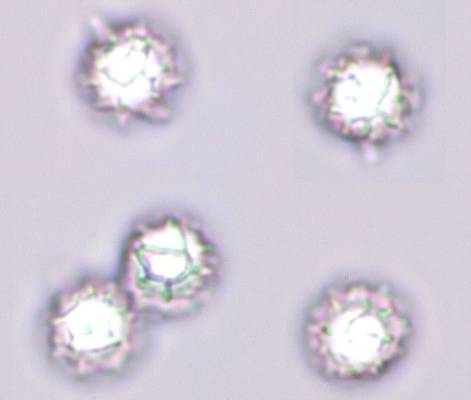Lactarius serifluus (DC.) Fr. - Watery Milkcap
Phylum: Basidiomycota - Class: Agaricomycetes - Order: Russulales - Family: Russulaceae
Distribution - Taxonomic History- Etymology - Identification - Culinary Notes - Reference Sources
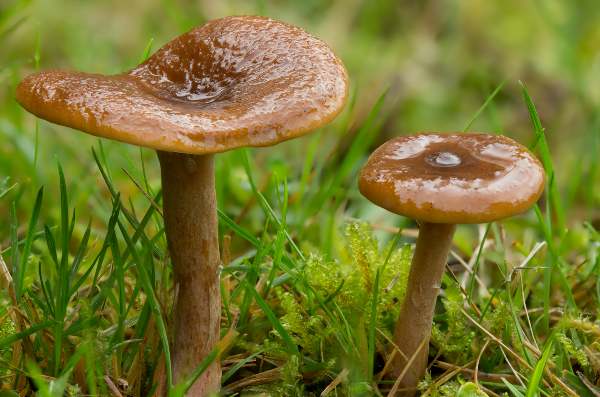
Lactarius serifluus, the Watery Milkcap, is found singly or in small groups beneath broadleaf trees, mainly oaks.
The milk (latex) that exudes from damaged gills is mild tasting and almost colourless; this together with its generally darkish colouring and wrinkled cap surface helps separate this species from the many other small brownish woodland milkcaps.
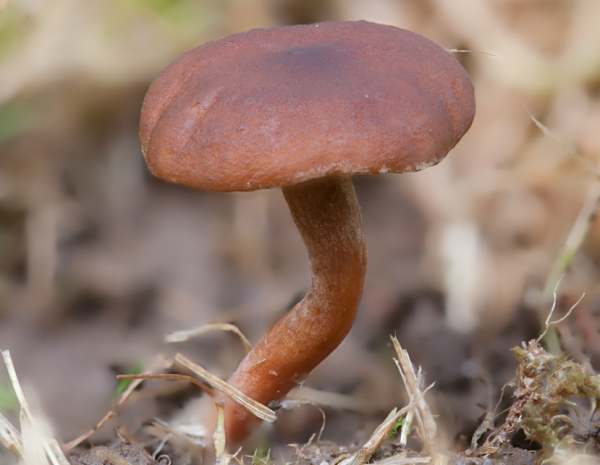
Distribution
Widespread but only an occasional find in Britain and Ireland, the Watery Milkcap is also found in many parts of mainland Europe from Norway down to Italy.
Taxonomic history
The Watery Milkcap was described in 1815 by Swiss botanist Augustin Pyramus de Candolle, who gave it the scientific name Agaricus serifluus. (Vast numbers of gilled fungi were dumped into the Agaricus genus in the early days of fungal taxonomy; most have since been moved to other genera leaving in the present-day Agaricus genus a much smaller number of gilled mushrooms that are sometimes referred to as the 'true mushrooms'.) Swedish mycologist Elias Magnus Fries sanctioned the basionym in 1838, establishing this milkcap's currently accepted scientific name as Lactarius serifluus.
Synonyms of Lactarius serifluus include Agaricus serifluus DC., Lactarius subdulcis var. cimicarius sensu Gray, Galorrheus serifluus (DC.) P. Kumm., Lactarius cremor ssp. Dahncke, Marchand, Neuhoff, and Lactarius noncamphoratus Bassler & Schaeff. (Some authorities recognise Lactarius subumbinatus as a distinct species; many others regard it as synonymous with Lactarius serifluus.)
Etymology
The generic name Lactarius means producing milk (lactating) - a reference to the milky latex that is exuded from the gills of milkcap fungi when they are cut or torn.
The specific epithet serifluus is derived from the Latin noun serum, meaning whey (the watery part of curdled milk), and the Latin verb fluo, meaning 'I flow'. It is a reference to the watery latex (milk) that flows from damaged gills of this milkcap mushroom.
Identification Guide
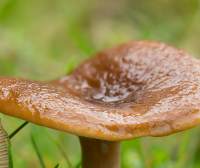 |
Cap2 to 8cm in diameter, the dark reddish-brown caps have a radially-wrinkled surface; convex at first, the caps flatten and may become slightly depressed witha small umbo as the fruitbody matures. |
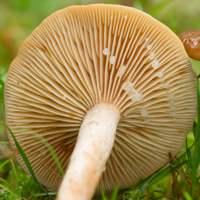 |
GillsThe clay-buff to clay-pink gills are adnate or weakly decurrent and moderately spaced to crowded. When the gills of this milkcap are damaged, a watery latex is released; it does not change colour, and its taste is mild. StemCylindrical, hollow, 3 to 13mm in diameter and 2.5 to 5cm tall, the stems are smooth and pale reddish-brown to orange-brown. There is no stem ring.
|
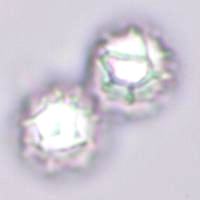 |
SporesBroadly ellipsoidal (almost spherical), 6-8.5 x 5.5-8μm, hyaline; ornamented with warts up to 1.2μm tall joined via a well-developed and almost complete network of ridges. Spore printPale creamy white. |
Odour/taste |
Odour slight, of Fenugreek (or some say of bugs!); taste mild. |
Habitat & Ecological role |
Ectomycorrhizal; in broadleaf and mixed woodland, usually under oaks but occasionally under birches. |
Season |
August to November in Britain and Ireland. |
Similar species |
Lactarius subdulcis is a milkcap with usually a paler cap; it occurs under beech trees. |
Culinary Notes
This species is not generally recommended as an edible mushroom, and some authorities consider it unfit or unsafe for human consumption.
Reference Sources
Fascinated by Fungi, 2nd Edition, Pat O'Reilly 2016, reprinted by Coch-y-bonddu Books in 2022.
Funga Nordica, Henning Knudsen and Jan Vesterholt, 2008.
Fungi of Switzerland, volume 6: Russulaceae, Kränzlin, F.
BMS List of English Names for Fungi.
Dictionary of the Fungi; Paul M. Kirk, Paul F. Cannon, David W. Minter and J. A. Stalpers; CABI, 2008
Taxonomic history and synonym information on these pages is drawn from many sources but in particular from the British Mycological Society's GB Checklist of Fungi.
Acknowledgements
This page includes pictures kindly contributed by David Kelly.
Fascinated by Fungi. Back by popular demand, Pat O'Reilly's best-selling 450-page hardback book is available now. The latest second edition was republished with a sparkling new cover design in September 2022 by Coch-y-Bonddu Books. Full details and copies are available from the publisher's online bookshop...
